History of Worlebury Golf Club
Worlebury Golf Club, founded in 1908, is located on Worlebury Hill, 2 miles from M5 Junction 21 and the beach town of Weston Super Mare, Somerset.
Its location at the Southwest's doorway provides beautiful views of the Severn Estuary and the South Wales coast to the north and the Mendip Hills to the south.
Worlebury Golf Club was formed in 1972 by Henry Butt, a local benefactor, and a group of like-minded, renowned businessmen who voluntarily donated their shares to the members for their enjoyment. We are one of the few golf clubs in the area with our own course and clubhouse.
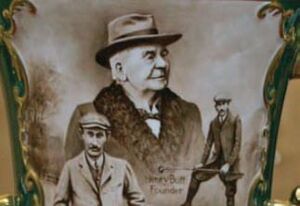
Henry Butt was a well-known local builder, entrepreneur, and donor to Weston-super-Mare who went on to become the Urban District Council's first mayor in 1937. He decided to take up golf around 1906 and applied for membership at Weston Golf Club. He was refused access on the grounds that Weston Golf Club was only for gentlemen and professionals, not artisans. He, on the other hand, was not to be defeated and was resolved to develop his own golf course. He looked around for good land. He decided against redeveloping a 9-hole course across Bleadon Hill, most likely because it was too close to Weston Golf Club. He also omitted a 9-hole course that ran over part of Sand Point towards Woodspring Priory since it was in such disrepair and had been abandoned. He chose Worlebury because he owned the quarry (now Ashbury Drive), and both materials and equipment were nearby. Worlebury was fairly desolate, and different people owned sections of property, yet it was often assumed to be common ground where sheep and cattle were free to roam over the hillside. Edward Hardwick, J. Palmer, and Richard Granville owned some of the land that he started to amass, and there is documentation that Mrs. Lomas received a payment of £2000 for the area where the 5th Green is now.
In those days there was only a footpath leading down to Monks Hill and the original golf course extended over what is now Woodspring Crescent, before houses were built. Apparently it was particularly hazardous for churchgoers walking down to Kewstoke Church because of golf balls being fired across the path.
Henry Butt (Chairman) and his fellow promoters, Wilfred Brown (Vice Chairman), Arthur E. Brown, T.Dixon, J.P Curtis, E.G.Lalonde, and W.C.Thomas, with J.Hodge, (Solicitor) and H.Hibbard, Secretary) set out to create first class facilities for both members and visitors alike. The organisation of the course started with hundreds of tons of soil being transported up Milton Hill by horsepower and also from Worle via the lane running up to the Observatory. Once the raw materials were assembled the promoters needed a course designer.
Harry Vardon, a professional golfer who had won the British Open on six occasions in 1896,1898,1899,1903, 1911 and 1914 was invited along with his brothers Alfred and Tom to assess the possibility of constructing a Golf Course. There is no record of any payment for their services and it seems likely that Henry Butt met all their expenses. Walls were removed, ground was levelled and stones removed. The holes being filled with leaf mould and a steamroller used to flatten the ground. It was estimated that 1500 tons of soil were used in the construction. Each hole had a distinctive feature, with most hazards being natural.
Harry Vardon only returned to Worlebury from time to time due to his many golf commitments but gave invaluable advice on course layout. His brothers Alfred and Tom seemed to oversee most of the construction. Alfred remained at Worlebury for about 16 years as the Club Professional. They laid out the course using the contours of the land to the best advantage. Alfred Vardon lodged in a cottage opposite the course with a Mr & Mrs Beacham. Mr Beacham known as "Tacker "was Henry Butt's foreman and assisted with the work of constructing the course. The Professional's Shop and living quarters were situated in Quarry Cottage, opposite the present green keepers building. One of the promoters Mr T. Dixon opened the first 9 holes on 30th May 1908 by driving a ball off the first tee. The ball was retrieved by Bert Dunston, preserved for posterity and is on display in the Club House. The following year a further 9 holes were opened. An article published in the local paper in 1910 stated "Quite recently a new Golf Course was opened on Worlebury Hill and its position is quite different from the one in Weston-super- Mare. The 18 hole course planned by Harry Vardon aided by his brother Alfred, the current professional, occupies a picturesque and healthy situation on splendid land with sea views. The turf is the finest and there are magnificent natural hazards and the course is always playable. The bogey of the course is 78 the record of which is held by the professional. The course is becoming very popular with residents owing to the good condition of the fairways and greens. The Secretary of the Club is Mr H. Hibbard".
The Club soon had 100 members with subscriptions being 1 guinea for Weston-super-Mare residents and 2 guineas for those living outside the Town.
Competitions offered valuable prizes. Fees were 1/6d per day and because the course was difficult to reach a wagonette was taken down to the railway station via High Street in the morning to bring players to the course. The wagonette did the return journey at lunch time dropping players who wanted lunch at Brown's Café (Mrs Brown was an early promoter of the club and obviously someone who had an eye for business) a similar journey was made in the afternoon. Players who did not travel by wagonette arrived by bicycle or pony and trap the ponies being left to graze on what is now the Club Car Park. The Architects Ward Price & Jane were commissioned to draw up plans to create a palatial clubhouse which would provide 6 bedrooms, 4 bachelor flats, billiard room, bathrooms and a smoking room, everything for the comfort of the visitor. The building would provide magnificent views across the Bristol Channel and surrounding countryside. The estimated cost was in the region of £2000. Whilst planning was underway temporary facilities were provided in an old cottage which the Club already owned located below where St Paul's School used to be situated. In addition refreshments were also available at the Observatory which was managed by James Ward.
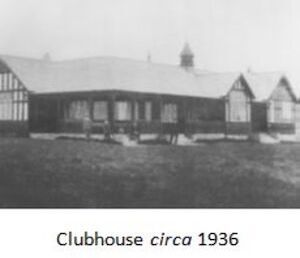
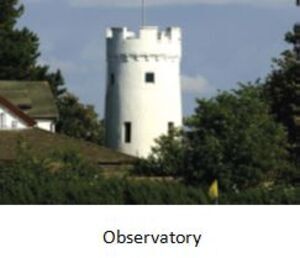
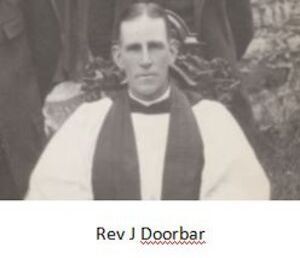
The first clubhouse was opened in 1911 and was a beautiful wooden building consisting of main lounge, common room, ladies room and men's changing room. There was a wooden balcony running the length of the building somewhat different from what was originally planned but photographs reproduced here bear out the description of the original building. The first Club Captain Rev J. Doorbar, Vicar of St. Paul's Kewstoke, was appointed in 1912 by which time the club had expanded and become affiliated to the EGU. He used to ride his horse up the stony track from Kewstoke, now referred to as Monks Steps; the horse was tethered to a post whilst he played his round. Golf was not played on Sundays leaving him free to hold church services.
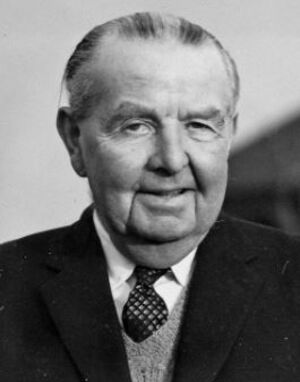
Our first recorded head green keeper was Bert Dunston who was a man who devoted his life to Worlebury Golf Club.
He was with the club when it opened in May 1908 and apart from 4 years spent in the forces from 1914-18 he remained with the club until his retirement. Through the years Bert was instrumental in many changes and improvements on the course. In the early days the course was looked after by 3 men and 3 horses with young Bert as an apprentice. Where today's greenkeeper shed is located is where the horses were kept and the original wall alongside the road still remains as do many of the lovely stone walls around the course. The last horse kept there was a gentle giant called Pugsley. As time progressed the Club acquired its first tractor which was like a steam roller with wheels 2ft 6ins wide. The course was not easy to maintain due to the rocky terrain with craters left from the early calamine and lead mines. On one occasion the tractor became stuck in one of these holes and had to be pulled out by the horse. In later years these craters were filled in with rubble from the demolished shops and cottages when Baytree Road was widened. The following extracts are from an article that appeared in The Mercury in 1958 to mark the Golf Club's Golden Jubilee. The reporter wrote "Mr. Dunston, his sun tanned face seemingly radiating good health is a wonderful advertisement for the outdoor life, has been connected with the game of golf since he was a boy, when he used to go caddying on the private course that was formally at Sand Point towards Woodspring Priory". Mr Dunston told the reporter he never wished to change his job, and added I have had a lot of hard work here and a lot of good times and pleasure being allowed to play and enjoy a game. When the club started in 1908 Bert joined as a caddie and then worked with Alfred Vardon who helped layout the course with his brother, Harry, a well known golfer who gave his name to the Vardon grip. Alfred was one of the best teachers anyone could have said Mr. Dunston. He was here for about 16 years and he made this place from the start. It was his teaching that brought on the club because most of the early members were practically all beginners. Mr Dunston said he started to train to become a professional but as he did not like it he asked to go out on the course. Describing his early caddying days at Worlebury, Bert said caddies were divided into first and second-class; payment for the first class was 9d and 7d for second class, for a round of 18 holes which took about 21/2hrs. Of this sum the Caddie Master, who was the Professional, would take 2d. Just recently a member asked a young lad if he would caddie for him and offered 2/6d to go round 9 holes. After a few minutes consideration the lad said he would do it for 5/-. They used to play over the road (Monks Hill) which had a high wire fence towards Monks steps and then back up again. In the other direction there used to be a hole near the Observatory and there was a gate half way which led into the quarry. The course has been made more compact, although it is still the same length, and has seen various improvements which are a credit to the work of the Directors and Members. In the Second World War a fire destroyed all but two rooms of the clubhouse. The flames could be seen for miles, we were fortunate because the Germans had been bombing the area for 13 nights but on that night they did not come, if they had, the whole area might have been bombed. Bert recalls that after playing on the course, Henry Cotton praised him for keeping the course in such good order. Bert said the course is a difficult one until you have been round a couple of times, I have seen 14 of the top players come here and only 2 could break 70 and they were Ward and Cotton in exhibition matches.
THE FORTIES TO THE SEVENTIES
During World War Two several Golf Courses were ploughed up to grow food but Worlebury got away without this, on condition that two families by the name of Dyer and Hartree were allowed to graze their animals on the land. A gate was erected to allow cows onto the 3rd fairway. Hay making was done to keep down the rough. All this was very labour intensive. In 1940 an anti aircraft gun was sited on the Course and soldiers billeted out by the 8th green. The concrete base which formed the base of the latrine block still exists to the left of the green. Posts were driven into the ground on the fairways by the MOD to stop light aircraft from landing. Despite all this golf continued to be played, these were just a few more hazards to avoid, any ball landing near a post had a free drop!! During the war the course was maintained almost single handed by Bert Dunston as there was little money available to pay the wages of green staff even if the men could have been found. The only equipment available was one tractor, a gang mower and a push mower. Despite these limited items the course was kept in good condition. American troops had an encampment in Worlebury Woods and they built the wide road from the Old Lodge to the water Tower to allow their tanks to gain access. They were allowed use of the clubhouse for special occasions. In 1942 the Clubhouse was almost destroyed by fire, not by enemy action although Bristol and the surrounding area had been bombed for 13 consecutive nights, but as reported by Gertrude Johnson, Club Secretary, by a carelessly discarded cigarette. The building being made of wood went up like a beacon, a sad end for a lovely clubhouse. The Americans helped with the fire fighting and were standing by to evacuate the area, so fierce was the blaze. The members then used the Professional's shop as a tea room and the 2 rooms remaining as changing areas. Later a wooden extension was added to make a kitchen and small dining room.
Sad times were ahead for the club members after the War with the effects of the fire and other war damage. Bill Webb, a Civil Engineer by profession obtained two Army Huts which were located on the cleared site of the old clubhouse. Later in 1949 when Don Lock was Captain a further hut was added to form a games room. They served as a clubhouse until 1965.Despite everyone's best endeavours there was a serious risk of the club going bankrupt. Dr Petty who was President from 1954-58 paid the wages of the staff for a short period of about a month. A couple of members Bernard Oldfield and Phillip Maggs decided to involve themselves in running the Club and set about trying to improve the fortunes of Worlebury GC. At that time the Club was a limited company with directors and players. In order for the players to maintain the course they had to approach the directors to obtain funds. Mr Brenner who was the owner of the pier wanted to take over all the shares in the Club previously held by the directors, but the membership was opposed. In 1953 an AGM was called and the Directors who until that time had run the club stood down and invited the members to take on responsibility. Bernard Oldfield and John King were subsequently elected to assist the members with running the Club. Leslie Long who was Captain in 1956/7 did a lot to rejuvenate the Club. Fruit Machines were introduced and the profits put into a separate fund to build a new clubhouse. Around this time the Observatory came up for sale and was offered to the membership for £12,500 as a clubhouse. One of the reasons it was turned down was because members travelling up from town on the bus would have had too long a walk from the bus terminus on Monks Hill to the Observatory. This was a missed opportunity; it would have made a stunning and individual clubhouse. In 1960 Gilbert Parrott became involved and it was with his acumen that the Club started to show a profit to the extent that they could afford to start building a new club house. Towards the end of the 1960s Gilbert Parrott wrote to all shareholders and invited them to donate their shares to the Club. Messrs Lloyd, Kelson and Leaver gave their shares on the understanding that trustees were appointed and that in the event of the Club being wound up the land would be given to a national Charity on the understanding that it could only be used for recreational purposes. In 1976 at a meeting in the Clubhouse Gilbert Parrott (Club President) and business men of the town, Jim Leaver and Wallace Kelson both of whom had inherited many of the original shares from their fathers handed them over on the same conditions as set out above and that it would remain for ever an 18 hole golf course. Jim Leaver told the Club trustees he knew that other share holders would be happy to agree to the transfer of their shares. Bernard Oldfield reported that as a result of these donations the Club members had a 100% voting power. Frank Maddocks, Captain (1976) who was at the handover said that Worlebury was one of the few clubs in the West Country that owned its own land. Pat Murphy Captain (1968/9) also present said that the club had 450 playing members and a 6 month waiting list. Thus Worlebury Golf Club became a members club. To quote one of our long standing members of the Club, Wally Hartree, the greatest tribute of all must be reserved for those who generously donated their shares to the members, so that they may enjoy golf in perpetuity set in this wonderful setting at the top of Worlebury Hill. We have a Private Members Club which is the envy of many, controlled by the members. This was brought about by the committee members who gave their time and effort in the early days to persuading the original shareholders to donate their shares. A new clubhouse was constructed in three stages the last being completed in 1968 - some 26 years after the destruction by fire of most of the first Clubhouse. The final stage cost £19,000 and the dining room furniture was presented by Philip Maggs, President 1975. Bernard Oldfield was instrumental in raising the money and organising the re-building. At last we had a presentable clubhouse. A lot of the money was raised by a monthly draw, or 200 club as it is now called. The main prize in the first year was a Mini car costing £600. After that a monthly cash draw was made. The 200 club continues to this day. In the 1970's Monks Hill was widened and 12 feet was taken off all the way down from the Clubhouse entrance to Woodspring Avenue. This was to the clubs advantage as it was only scrubland - a new wall was built at the Local Councils expense and the Club received a substantial amount of money for the sale of the land. The entrance to the Clubhouse was improved, the contractors wanted to build a bus shelter into the wall with a fitted seat which would have been an asset to the area but the Council would not allow it and insisted on erecting an old shelter brought from the Bournville, which blew down a few months later.
MORE RECENT TIMES
The next major changes to the Golf Club started in the late 1990's. The existing club house was by then 30 years old and was beginning to show its age. Although it had a flat roof it was not all on one level and where the different levels met leaks were starting to become a regular occurrence. Renewing the roof was becoming a matter of some urgency. However the overall condition both internally and externally of the building was in need of up dating. The kitchen was small and poorly laid out and food had to be carried across the back bar to the dining room. It was decided as a first step that the House Committee would look at the option of making improvements to the existing internal layout and the re-roofing of the building. Under the Chairmanship of Harry Mellor plans were drawn up to provide improvements to the internal layout and estimates were obtained which included the cost of re- roofing the building. Robert Rogers was elected House Chairman at the Annual General Meeting in 2000. Under his Chairmanship the House Committee continued to pursue all options but it became apparent that to refurbish the existing building would not only be costly it would not in the long run provide the best solution. The House Committee reported back to the Council and it was decided to look at the options for a new club house. There were some false starts along the way but with the guidance of Mike Tilke, Club Chairman, the membership arrived at a decision in 2003 to employ a local builder, Graham Haskins, to provide a new clubhouse. To meet the cost of the new building the membership agreed that a sum of £125,000, which had been ring fenced for some 10 years since the VAT paid on subscriptions over several earlier years was refunded by Customs & Excise, together with interest accrued thereon could be put towards the new building. The sale of two flats on Worlebury Hill Road owned by the Club raised a further £120,000. Members were invited to give loans in units of £500 which raised £96,500 and a loan from the Bank of £150,000.The balance being met by an overdraft facility of £50,000 which would be available to the Club when required during the financial year. In 2007 the membership agreed to the sale of the remainder of the property on Worlebury Hill Road with the proceeds being used to pay off the bank loan and reduce the overdraft facility. The new clubhouse was not, in its early days, without its critics. We like to think that it is now accepted and enjoyed by the majority of members. It is certainly admired and envied by the many visitors to the Club, providing as it does a magnificent panorama over the course, to the Bristol Channel and Wales.
COURSE DEVELOPMENTS OVER THE YEARS
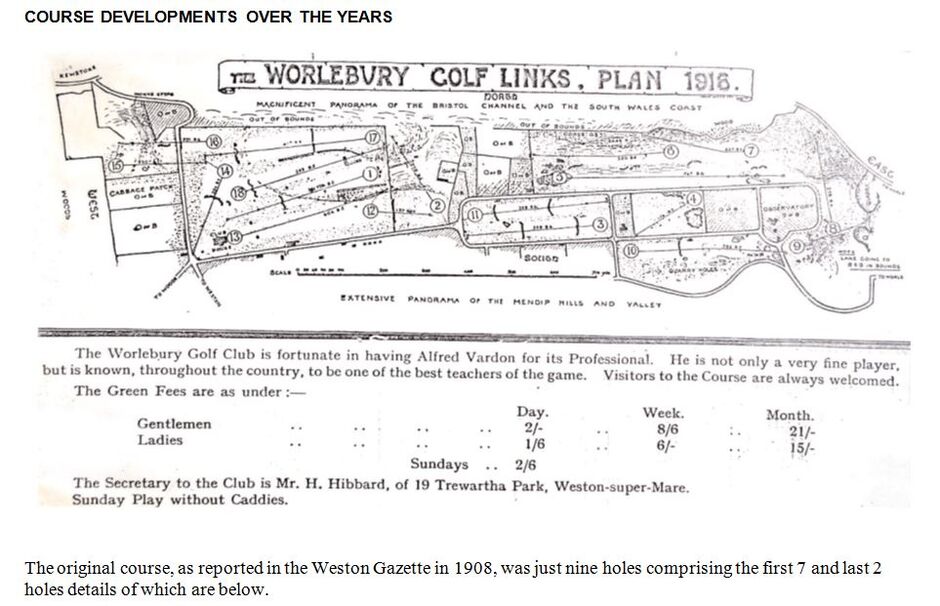
| Hole | Bogey | Length |
|---|---|---|
| 1 | 4 | 195 |
| 2 | 4 | 209 |
| 3 | 4 | 190 |
| 4 | 5 | 333 |
| 5 | 5 | 383 |
| 6 | 5 | 360 |
| 7 | 4 | 214 |
| 17 | 4 | 267 |
| 18 | 4 | 240 |
Sadly there are no details of the other 9 holes which were added in 1909 because of the fire in 1942 all we know is that the bogey for the 18 holes was 78. Above is a reproduced copy of the course layout as it was in 1916. The next record of changes came in the 1930s when the holes which used to be across the far side of Monks Hill in what is now Woodspring Avenue were given up for building land. In a Club handbook dated 1936 the course details are describe as follows:- In the 1950s the Club lost the 10th hole which was at the time a par 3 situated behind the Observatory. This meant a new hole would urgently have to be created to replace the loss. The then owner of the Observatory kindly allowed the Club to use a small piece of land to be used for this purpose. However, after a short period of time the Observatory was put up for sale, and once more a new hole had to be created. In the short term the now 16th hole was played twice, as the 4th and 18th. Eventually a short hole was created by digging into the bank below our present 6th green; this formed a new hole which would then become the 9th after the course was rerouted. In the 1960s the services of Mr Fred Hawtree one of the leading architects in the country at the time were sought. Plans were created, and various meetings and discussions held on how the course could be improved. It was suggested that an additional hole could be created in the 5th field, which consisted of two holes. Unfortunately, the area suggested could only be best described as a neglected field, consisting mainly of humps and bumps. Although the architect was not totally convinced we could create three holes in this field, plans went ahead. Fortunately, at the time, a lot of housing redevelopment was being carried out at the top of Baytree Rd. One of our members Mr Bernard Oldfield a leading light in the area spoke to the contractors who were only too pleased to tip the surplus soil and rubble from the various builds into the existing craters. through the generosity of another of the members Phillip Maggs who had donated a piece of land where our present 5th tee and 7th green are situated, we now had sufficient land to go ahead and create the required new holes. This was a massive undertaking and in order to assist in the financing part of the area behind the now 6th tee was sold to the quarry for a sum in the region of £10,000. At the time Phillip Maggs again kindly financed the project, by paying for the repositioning of the "˜right of way' to Stoneycroft and Rose Cottage to its present position behind the 5th tee. The project was finished and the new holes opened in 1965 - the work took approximately 4 years to complete. Following numerous complaints over the years from the owners of Rose Cottage about wayward tee shots, the decision was taken to lower the 7th tee. In recent years the tee has been levelled and a footpath created from the 6th green down to the 7th tee. Around the same time, Phillip Maggs purchased two small plots of land, one on the north side of the 17th fairway and the small area in front of the 14th tee. This allowed the 3rd hole to be extended back to its current position and the 14th to be extended, it also created an area in front of the 14th tee where surplus soil and rubble could be stored. In the late 1980s, following numerous complaints from the stable owners regarding stray golf balls, and on the advice of our insurance company it was decided to move the 4th tee to a more central position. However, the situation did not improve, and again on the advice of our insurers it was agreed that the tee be moved back to its previous location. At the same time, a metal fence was erected to the right of the tee, a number of trees were planted, and bunkers were created to encourage golfers to play away from the stables. In the late 70s early 80s flushed with the success of creating the alterations to the 5th, 6th and 7th the green staff at the time went about creating the now short 12th hole, and to landfill the 11th and 12th fairways. Prior to commencement various contractors were again approached for soil/rubble to level and reposition the 11th green and 12th fairway at the time both were on extremely steep slopes. The work was carried out on a very tight budget and took several years to complete. By creating this additional hole the opportunity was then taken to lengthen the now 15th to a par 5, and eliminate the old 5th hole, thus creating our current practice area.
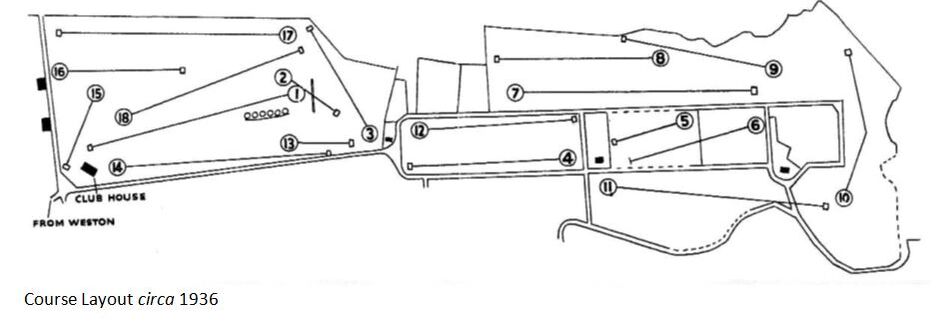
Length of the Holes
| Hole | Length | Bogey |
|---|---|---|
| 1 | 450 | 5 |
| 2 | 90 | 3 |
| 3 | 253 | 4 |
| 4 | 310 | 4 |
| 5 | 146 | 3 |
| 6 | 260 | 4 |
| 7 | 455 | 5 |
| 8 | 341 | 4 |
| 9 | 348 | 4 |
| 10 | 293 | 4 |
| 11 | 415 | 5 |
| 12 | 313 | 4 |
| 13 | 144 | 3 |
| 14 | 450 | 5 |
| 15 | 186 | 3 |
| 16 | 180 | 3 |
| 17 | 430 | 5 |
| 18 | 407 | 4 |
| OUT | 2653 | 36 |
| IN | 2818 | 38 |
LENGTH OF THE COURSE 5471YDS SCRATCH SCORE 70



